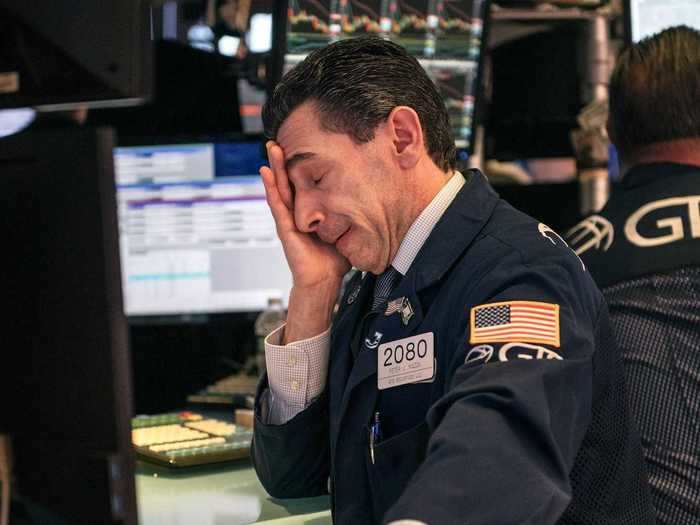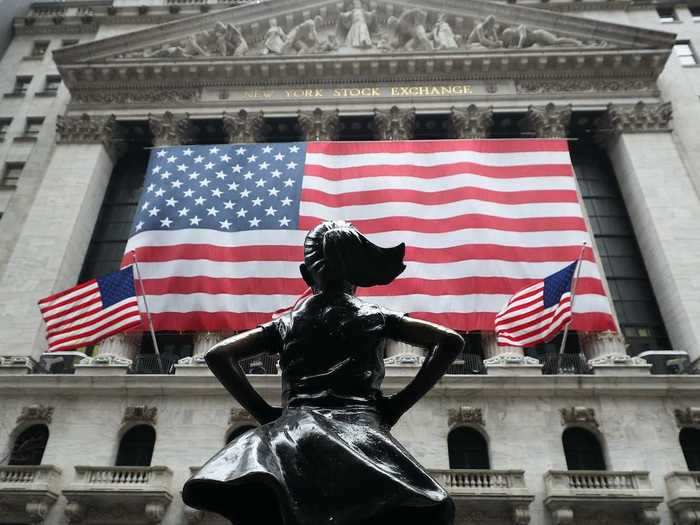A man walks near a Bank of America branch in New York's Times Square Decemeber 11, 2008. REUTERS/Brendan McDermid
- Bank of America highlighted five key stock market trends that emerged from S&P 500 firms' first-quarter earnings reports.
- The period's profits landed about 9% below analyst estimates and 15% lower than their year-ago levels, according to the bank.
- Economists expect the second quarter to host the worst of the coronavirus' fallout, leading any new patterns to shape investor actions moving forward.
- Here are the five trends revealed by first-quarter reports, from consensus estimates for a V-shaped rebound to concentrated damage to a handful of sectors.
- Visit the Business Insider homepage for more stories.
With 95% of S&P 500 companies having reported their first-quarter results, Bank of America highlighted key trends emerging from the coronavirus-addled market.
Profit- and revenue-estimate cuts slowed through May, the bank said in a Monday note, signaling that a market floor could be emerging. First-quarter results broadly landed 9% below analyst hopes and 15% lower than their year-ago levels. Yet economists expect the second quarter to feature the greatest fallout as layoffs intensified and credit struggles turned into bankruptcies.
Even as uncertainty continues to cloud the investing landscape, key patterns could guide investors toward safe havens and away from dangerous sectors. Here are the five trends Bank of America found in first-quarter reports.
Read more: A Wall Street chief strategist analyzes 4 recessions throughout history to explain why investors should still be buying stocks — even as the economy hurtles into depression
Read the original article on
Business Insider
Halted margin growth
Getty Images
Non-financial net margins sank to their lowest since the start of 2017 through the first quarter, the team led by Savita Subramanian said. The consumer discretionary, energy, and industrial sectors posted the bulk of corporate profit slippage through the period, and a bumpy return to past activity could prolong a rebound for the crucial metric.
Bank of America's Corporate Misery Indicator also flashed a dire signal over the quarter, hinting at both a macro and micro hit to companies' margin expansion efforts.
Concentrated damage
After being closed for several weeks due to the coronavirus outbreak, Chandler Fashion Center Mall welcomes back patrons with many social distancing guideline signs Sunday, May 17, 2020, in Chandler, Ariz. Much of the country remains unlikely to venture out to bars, restaurants, theaters or the gym anytime soon, despite state and local officials increasingly allowing businesses to reopen. That's according to a new survey by The Associated Press-NORC Center for Public Affairs Research. (AP Photo/Ross D. Franklin)
Associated Press
While the virus-fueled sell-offs through February and March dragged on nearly all stocks, the pandemic's fallout was relatively crowded in a few corners of the market. Major misses in the financial and discretionary sectors tanked related equities, but seven out of 11 sectors generally bested estimates through the quarter, Bank of America said.
The trend has continued into the current quarter, with certain industries quickly returning to past highs. Tech, in particular, has thrived as investors bet on such firms to ride out the pandemic.
Cash over cash-return
Companies generally shifted from generous stock buybacks and dividend programs to conserving cash where needed. About one-fifth of firms suspended buybacks, and 10% of companies either ended or slashed dividend payments, the team wrote. The bank's capital expenditure guidance ratio sits at its lowest since the financial crisis, suggesting firms will prioritize liquidity over shareholder benefits until the economy rebounds and credit stresses abate.
Operating through the unknown
REUTERS/Shannon Stapleton
One-third of companies pulled their forward guidance last quarter as the coronavirus' path remained extremely murky. Hopeful language on earnings calls tumbled to the weakest level in Bank of America's data history, further emphasizing uncertainty among corporate leadership.
Those suspending their forecasts didn't enjoy much empathy from investors. Only 21% of such firms beat earnings estimates in the first quarter compared to 33% for companies keeping their guidance. Apple stood out as a prime example, with its lack of next-quarter guidance overshadowing a surprise increase in revenue through the start of the year. The iPhone maker's shares dipped as much as 2.4% in the following session.
A V-shaped illusion
New York Stock Exchange building is seen at the Financial District in New York City, United States on March 29, 2020.
Tayfun Coskun/Anadolu Agency/Getty Images





